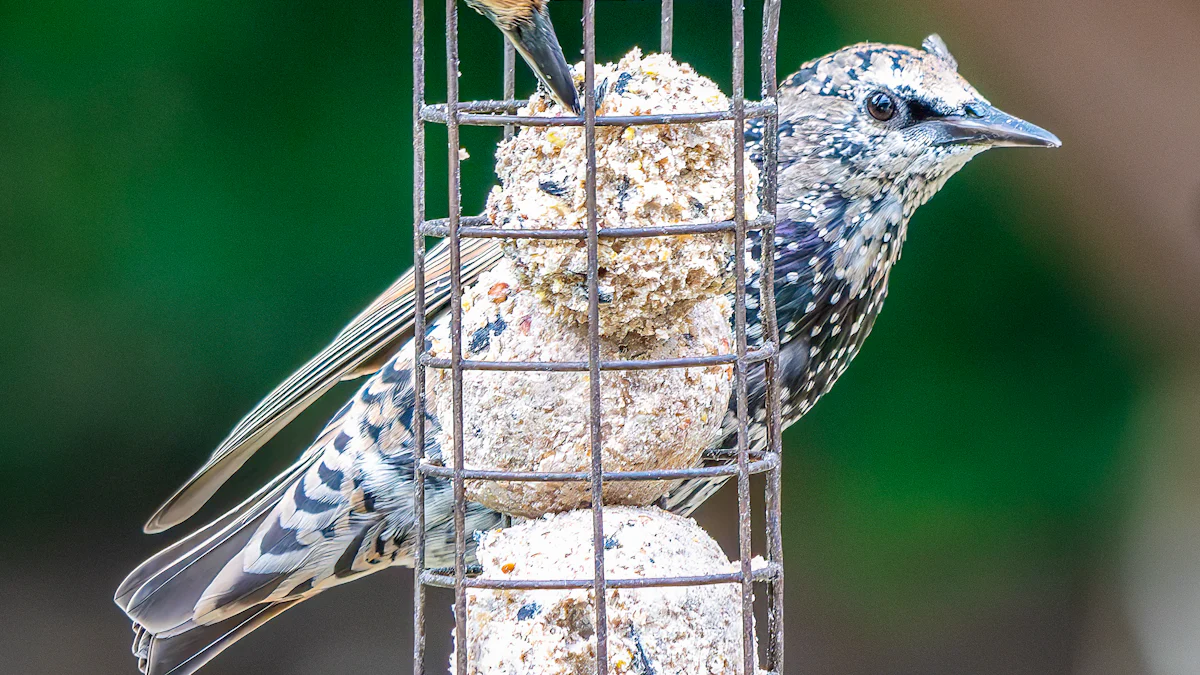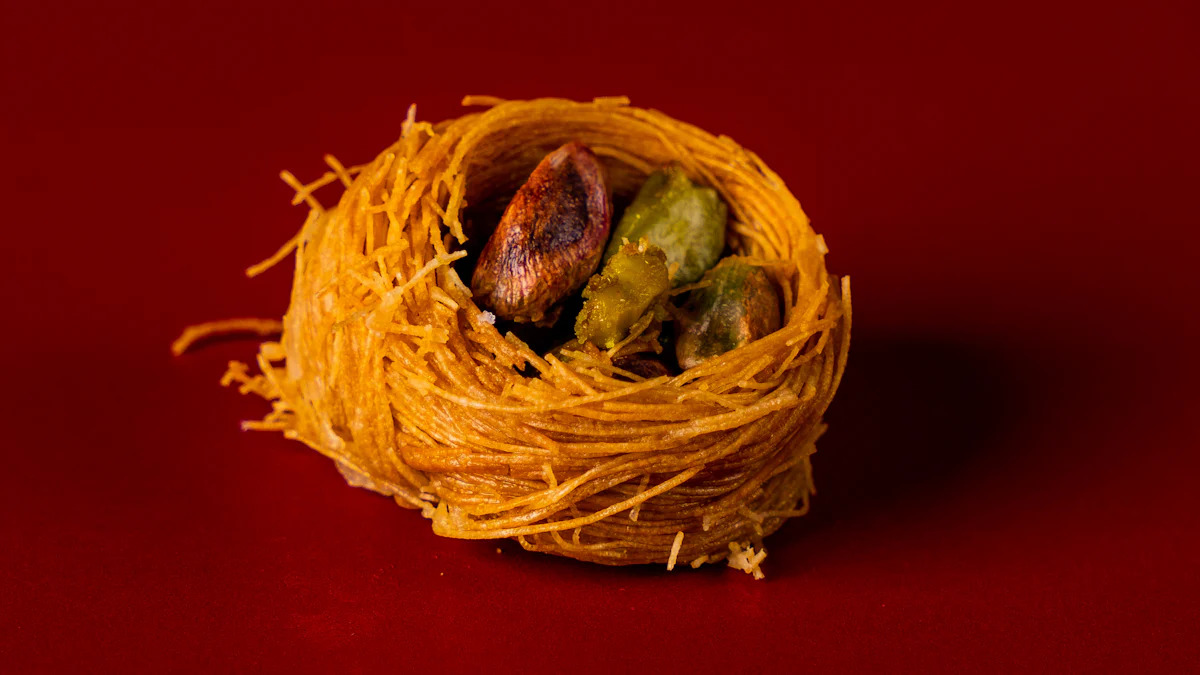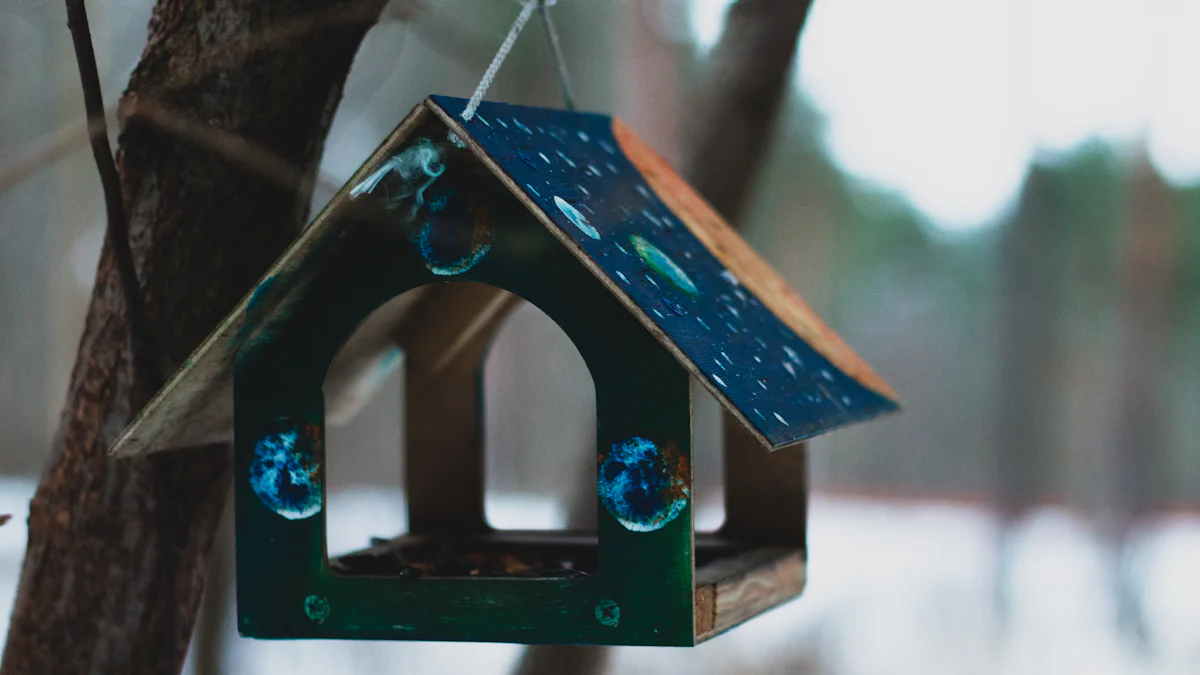
Storing dried mealworms the right way keeps them fresh and safe for your feathered friends. An airtight container works best to lock in freshness and block out air. Place it in a cool, dry spot to avoid spoilage. This simple step ensures your Bucket Dry Bird Mealworms Food stays appealing and nutritious. Birds love mealworms when they’re stored properly, and you’ll enjoy seeing them flock to your yard.
Key Takeaways
- Use airtight containers to keep dried mealworms fresh and prevent spoilage from air exposure.
- Store mealworms in a cool, dry place to maintain their nutritional value and avoid moisture-related issues.
- Regularly check for spoilage or pests to ensure the mealworms remain safe and appealing for birds.
- Rehydrate mealworms before serving to make them more enticing for your feathered friends.
- Observe bird activity to determine the right portion sizes and adjust feeding practices accordingly.
- Keep feeding areas clean and safe to promote bird health and encourage regular visits.
- Attract a variety of bird species by mixing mealworms with other bird foods for a balanced diet.
Why Proper Storage Matters
Proper storage of dried mealworms is essential to ensure they remain fresh, safe, and appealing for birds. Let’s explore why it’s so important to store your Bucket Dry Bird Mealworms Food correctly.
Maintaining Freshness and Nutritional Value
Birds rely on mealworms for their high protein and fat content. When you store them properly, you preserve these nutrients. Airtight containers prevent air exposure, which can cause the mealworms to lose their freshness. Keeping them in a cool, dry place also helps maintain their quality. Fresh mealworms mean healthier birds and more activity in your yard.
Preventing Spoilage and Contamination
Spoiled mealworms can harm birds. Exposure to moisture or heat can lead to mold or bacterial growth. Contaminated food may deter birds from eating or even make them sick. By using proper storage methods, you ensure the mealworms stay safe and edible. This simple step protects the birds you care for and keeps your feeding routine trouble-free.
Protecting Against Pests and Moisture
Improperly stored mealworms can attract pests like ants, beetles, or rodents. Moisture can also ruin the mealworms, making them clump together or develop mold. Airtight containers act as a barrier against pests and humidity. Placing the container in a dry, shaded area adds another layer of protection. These precautions keep your Bucket Dry Bird Mealworms Food in top condition for your feathered visitors.
Easy Storage Tips for Bucket Dry Bird Mealworms Food

Keeping your Bucket Dry Bird Mealworms Food fresh and safe doesn’t have to be complicated. With a few simple steps, you can ensure your mealworms stay in top condition for your feathered visitors. Let’s dive into some practical storage tips.
Use Airtight Containers
Airtight containers are your best friend when it comes to storing dried mealworms. They seal out air, which helps maintain freshness and prevents spoilage. Choose a container with a secure lid that locks tightly. Plastic or glass containers work well, as long as they’re durable and easy to clean. By using an airtight container, you also keep pests like ants or beetles from sneaking in. This small investment goes a long way in preserving the quality of your Bucket Dry Bird Mealworms Food.
Store in a Cool, Dry Place
Temperature and humidity play a big role in keeping mealworms fresh. Find a cool, dry spot in your home, like a pantry or cupboard, to store your container. Avoid areas near heat sources, such as stoves or radiators, as high temperatures can cause the mealworms to lose their nutritional value. A dry environment also prevents moisture from seeping in, which could lead to mold or clumping. Keeping your mealworms in the right location ensures they stay appealing and safe for birds.
Avoid Exposure to Moisture and Humidity
Moisture is the enemy of dried mealworms. Even a small amount can ruin an entire batch by causing them to stick together or grow mold. Always check that your container is completely dry before adding mealworms. If you live in a humid area, consider adding a food-safe desiccant packet to the container. These packets absorb excess moisture and provide extra protection. Taking these precautions ensures your Bucket Dry Bird Mealworms Food remains in perfect condition for your backyard birds.
Keep Away from Direct Sunlight
Sunlight can harm your dried mealworms more than you might think. Direct exposure to sunlight raises the temperature inside the container, which can degrade the mealworms’ nutritional value. It also increases the risk of condensation forming inside, leading to moisture buildup. To avoid these issues, store your Bucket Dry Bird Mealworms Food in a shaded area. A pantry, cabinet, or any spot away from windows works well. If you must place the container near a window, use curtains or blinds to block the sunlight. Keeping your mealworms out of direct sunlight ensures they stay fresh and appealing for your backyard birds.
Regularly Check for Spoilage or Pests
Even with proper storage, it’s important to inspect your mealworms regularly. Look for signs of spoilage, such as mold, clumping, or an unusual smell. These indicate that moisture or heat may have compromised the batch. Also, check for pests like ants or beetles that might have found their way into the container. If you notice any issues, discard the affected mealworms immediately to avoid harming the birds. Make it a habit to examine your Bucket Dry Bird Mealworms Food every few weeks. This simple routine helps you catch problems early and keeps your feathered friends safe and healthy.
How to Use Bucket Dry Bird Mealworms Food for Bird Feeding

Rehydrating Mealworms for Better Appeal
Dried mealworms are convenient, but rehydrating them can make them even more enticing for birds. To do this, soak the mealworms in warm water for about 20-30 minutes. This process softens them, making them resemble live mealworms, which many birds find irresistible. Rehydrated mealworms are especially helpful during dry seasons when birds need extra hydration. After soaking, drain the water and serve the mealworms immediately. Avoid leaving them out for too long, as they can spoil quickly once rehydrated. By taking this simple step, you’ll make your Bucket Dry Bird Mealworms Food even more appealing to your feathered visitors.
Serving Mealworms to Birds
Offering mealworms to birds is easy and rewarding. Use a feeder designed specifically for mealworms or a shallow dish that birds can easily access. Place the feeder in a visible and safe spot, such as near shrubs or trees, where birds feel secure. Start with a small amount to gauge how much the birds in your area consume. Refill the feeder as needed, but avoid overloading it to prevent waste. Birds will quickly learn where to find the mealworms, and you’ll enjoy watching them return daily. Serving your Bucket Dry Bird Mealworms Food this way ensures a steady stream of happy, well-fed birds in your yard.
Mixing Mealworms with Other Bird Food
Combining mealworms with other bird food can attract a wider variety of species to your yard. Mix them with seeds, suet, or nuts to create a balanced and nutritious blend. This approach works well for feeders that cater to multiple bird types. For ground-feeding birds, sprinkle the mixture on the ground or in a tray feeder. Mixing mealworms with other foods also helps stretch your supply, making it last longer. Birds love variety, and this method keeps them coming back for more. By incorporating your Bucket Dry Bird Mealworms Food into a mix, you’ll create a feeding station that appeals to all kinds of birds.
Determining Portion Sizes Based on Bird Activity
Finding the right portion size for your birds can make a big difference in their feeding experience. Observing bird activity in your yard helps you decide how much Bucket Dry Bird Mealworms Food to offer. Here’s how you can determine the ideal amount:
-
Start Small and Observe
Begin with a small handful of mealworms in your feeder or dish. Watch how quickly the birds consume them. If they finish the mealworms within a few hours, you can gradually increase the portion. If leftovers remain by the end of the day, reduce the amount next time. This trial-and-error approach ensures you’re not overfeeding or wasting food.
-
Consider the Number of Birds
The number of birds visiting your yard directly impacts how much food you’ll need. A larger flock will require more mealworms, while a smaller group will need less. Pay attention to peak feeding times when bird activity is highest. Adjust portions based on how many birds show up during these periods.
-
Account for Seasonal Changes
Bird activity often changes with the seasons. During breeding or migration seasons, birds may need more energy and protein, so you might want to increase the portion size. In quieter months, like late summer or winter, fewer birds may visit, so smaller portions could suffice. Keeping an eye on seasonal patterns helps you provide just the right amount.
-
Avoid Overfeeding
Overfeeding can lead to wasted food and attract unwanted pests. If you notice mealworms piling up or going uneaten, scale back the portions. Birds thrive on fresh food, so offering just enough ensures they get the best quality mealworms without leftovers spoiling.
-
Adjust Based on Bird Behavior
Birds are creatures of habit. If you notice them returning at specific times or in larger groups, adjust your portions accordingly. Their behavior gives you clues about their feeding needs. By staying attentive, you’ll create a feeding routine that works for both you and your feathered visitors.
By tailoring portion sizes to bird activity, you’ll keep your Bucket Dry Bird Mealworms Food fresh and appealing. This thoughtful approach not only minimizes waste but also ensures your backyard birds stay happy and well-fed.
Additional Tips for Bird Feeding Success
Best Times to Feed Birds
Timing plays a big role in attracting birds to your yard. Birds are most active during the early morning and late afternoon. These times are when they search for food to fuel their energy for the day or prepare for the night. Set up your feeding station before sunrise to catch their morning activity. Refill feeders in the late afternoon if needed.
Consistency also matters. Birds remember feeding routines. If you feed them at the same time daily, they’ll return regularly. This habit helps you enjoy more birdwatching moments while ensuring they get the nutrition they need.
Attracting Specific Bird Species with Mealworms
Mealworms are a favorite for many bird species, but you can use them strategically to attract specific ones. Bluebirds, robins, wrens, and chickadees love mealworms. To draw these birds, place mealworms in feeders designed for their size and feeding habits. For example, bluebirds prefer open dish feeders, while wrens might enjoy a covered feeder for added security.
You can also mix mealworms with other foods that appeal to certain species. Adding seeds or suet alongside mealworms creates a diverse menu. This variety encourages a wider range of birds to visit your yard. Observing which birds come to your feeders helps you adjust your offerings to suit their preferences.
Keeping Feeding Areas Clean and Safe
A clean feeding area keeps birds healthy and ensures they return. Dirty feeders can spread diseases among birds. Make it a habit to clean your feeders weekly. Use warm water and mild soap to remove dirt and residue. Rinse thoroughly to avoid leaving harmful chemicals behind.
Clear the ground beneath feeders regularly. Dropped food can attract pests like rodents or ants. It can also grow mold, which is harmful to birds. Place feeders in areas with good drainage to prevent water from pooling around them.
Safety is just as important as cleanliness. Position feeders away from predators like cats. Choose spots near shrubs or trees where birds can quickly find shelter. By keeping feeding areas clean and safe, you create a welcoming environment for your feathered visitors.
Observing Bird Behavior to Adjust Feeding Practices
Paying attention to bird behavior can help you fine-tune your feeding practices. Birds communicate their needs through their actions, and by observing them closely, you can create a more inviting and effective feeding environment. Here’s how you can use their behavior to guide your approach:
-
Notice Feeding Patterns
Watch when birds visit your feeders most often. Early mornings and late afternoons are usually the busiest times, but some species may have unique schedules. If you notice a specific time when activity peaks, make sure your feeders are stocked and ready. This ensures birds find food when they need it most.
-
Identify Preferred Feeding Spots
Birds often show a preference for certain feeders or locations in your yard. Some may favor a feeder near shrubs for added security, while others might prefer an open area. Take note of where they gather most frequently. Adjust the placement of your Bucket Dry Bird Mealworms Food to match their preferences and make feeding more comfortable for them.
-
Watch for Signs of Overcrowding
If you see too many birds competing for space at a single feeder, it’s time to add more feeding stations. Overcrowding can stress birds and lead to aggressive behavior. Spreading out feeders across your yard gives them plenty of room and reduces competition. This simple change can make your yard more welcoming for all visitors.
-
Observe Eating Habits
Some birds may eat quickly and leave, while others linger and return multiple times. If you notice mealworms disappearing too fast, you might need to increase portions. On the other hand, if leftovers remain by the end of the day, reduce the amount to avoid waste. Their eating habits provide valuable clues about how much food to offer.
-
Look for New Visitors
Keep an eye out for new bird species in your yard. Different birds may appear during migration seasons or as the weather changes. Adjust your feeding practices to cater to these newcomers. For example, you might mix mealworms with seeds or suet to attract a wider variety of birds. Welcoming new visitors adds excitement to your birdwatching experience.
-
Pay Attention to Body Language
Birds often display subtle cues that reveal their comfort level. If they seem hesitant to approach a feeder, it could be too exposed or close to potential predators. Move the feeder to a safer spot, such as near trees or bushes. When birds feel secure, they’re more likely to return regularly.
By observing these behaviors, you’ll gain a deeper understanding of your feathered friends. Adjusting your feeding practices based on their actions creates a more enjoyable experience for both you and the birds. It’s a rewarding way to connect with nature and ensure your Bucket Dry Bird Mealworms Food is always put to good use.
Storing dried mealworms the right way keeps them fresh and safe for your backyard birds. Airtight containers and a cool, dry spot are all you need to maintain their quality. When you store them properly, you ensure birds get the nutrition they need while enjoying their visits to your yard. Adding mealworms to your feeding routine attracts a variety of species and makes birdwatching even more rewarding. Start today, and you’ll create a healthier, happier environment for your feathered friends. Your efforts will bring life and activity to your outdoor space!


